Americans:
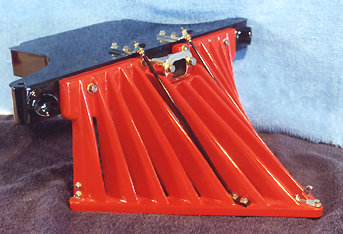
"#40 Cow Catcher"
On a modern engine we use
the term "Pilot", but this is a COW CATCHER! Nice red
and black automotive paint and gold plated brass! Gold plating
is pretty inexpensive if you polish all the parts yourself and
then mount them on brass strips so the platers don't have to
handle them. This also prevents tiny parts from getting lost.
I usually fabricate cow catchers from hardwood, but MR. Gilday
had this nice casting from Railroad Supply.
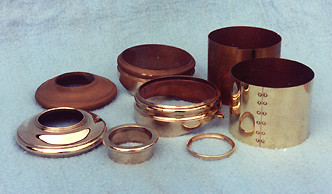
"Domes"
These dome castings were
very nice but still needed some cleaning up. The first thing
was to cut off the mounting lugs and sand outlets. Then they
could be chucked up in the lathe and turned and polished. After
all the turning and polishing was done the mounting lugs and
sand outlets were silver soldered back on. Then just a light
buff on a cloth wheel and you can see the results. All the polished
brass was gold plated on this engine, that way you could run
it all day long and the brass wouldn't tarnish. Something to
consider on an engine with this much brightwork.
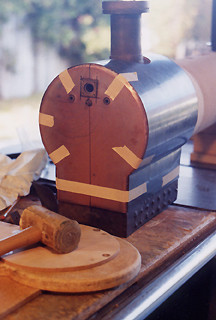
"Fitting Backhead Wrapper"
Here we are fitting the
boiler jacket to the backhead wrapper. Make sure to allow for
the thickness of the insulation under the backhead wrapper and
use little #1-72 or #0-80 screws to join them. When fitting the
boiler jacket to the backhead wrapper put a couple layers of
masking tape between them to allow for the thickness of the paint,
or you will tear you hair out later trying to get the holes to
line up!

"American" photo "Forming Backhead wrapper"
A backhead wrapper is something
that will add to the appearance of a loco and perhaps also the
performance, as you can put some insulation under it. This wrapper
was made of .032" copper. I now make them from .062"
copper as it doesn't wrinkle so easily. Make a form out of particle
board or MDF (medium density fiberboard). Hold it in place on
the form with a piece of 1/4" plywood and some "C"
clamps. Then start working the edges over the form with a rawhide
mallet. Don't use a metal hammer or you will put dents in the
copper! You will have to remove the copper from the form and
anneal it a several times by heating it to dull red and quenching
it in cold water. The colder the water the better, I use ice
water.
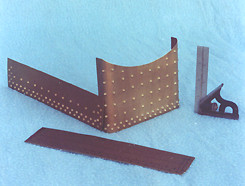
Here is the firebox wrapper for #40.
A firebox wrapper is a
fairly simple way to improve the appearance of most any steam
loco, even a narrow firebox engine, but will greatly add to the
appearance of a modern wide firebox engine. This wrapper is made
from .020" shim brass. The rivets are just embossed as there
isn't room between the frame and actual firebox for real rivets.
On a steam loco with hollow stays you can use 3/32" pop
rivets to simulate them. There just wasn't room here.
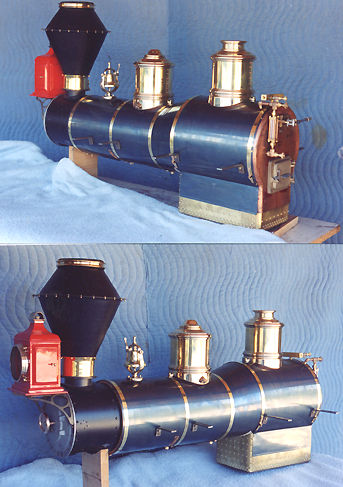
"#40 Boiler & Wrappers"
Here we have all our work
making wrappers and such starting to pay off. You can see how
the backhead wrapper trims out the boiler in the cab. And also
how the firebox wrapper gives the boiler a prototypical look,
not nearly as important on a narrow firebox tea kettle as a modern
wide firebox engine. This is one detail that really pays off!
{BACK}
{HOME} {A&C SHOPS} {BERKSHIRE} {AMERICANS} {No. 9} {CARS} {JEWELRY} {CONTACT}

copyright
© 2004, Jack Bodenmann, all rights reserved.